In this article, we review the Topping E50 DAC & the Topping L50 AMP. They respectively cost $269 USD and $229 USD.
Disclaimer: ShenzhenAudio sent us the E50 & the L50 for this review, free of charge. I only covered the customs fees & taxes. All thoughts and experiences with the product are naturally my own.
This review consists of 3 pages. The Topping E50 will be reviewed on page 1, the Topping L50 will be reviewed on page 2 and the joint performance of the two will be evaluated on page 3.
Topping E50 Balanced Desktop DAC with MQA
The Topping E50’s dedicated web page can be found here. It costs $269 USD from Shenzhen Audio.
The Topping E50 is a budget-oriented, high-performance DAC that can decode PCM up to 32bit-768kHz and DSD up to DSD512, natively, via USB. It is powered by the ESS Technology’s ES9068AS premium-tier DAC. Topping has been designing a lot of great value DACs and I am happy to say that this one is also one of them. I sincerely hope that Topping’s streak continues and thus keeping the competition fire alive, for us Audiophiles. I have listed the highlights of the E50 below.
- ESS Technology ES9068AS DAC
- XMOS XU216 USB Controller
- Ultra Low-Jitter CPLD
- Balanced TRS + Unbalanced RCA
- DAC / PRE Modes
- Remote Control Support
- MQA Full + 16bit-32bit, PCM 44.1kHz-768kHz
- DSD DSD64-DSD512 (Native Support)
Packaging & Accessories
Topping’s E50 DAC comes in a medium-sized, white rectangular box. The box design is simple. There are no specifications or any product info listed anywhere on the box. There is a sticker with the model name and barcode on it and that’s all. Upon opening the box, you’re welcomed by the foam compartment that protects the device from damage during transportation.
As for the accessories, Topping provides you with a USB-A to USB-B cable, a remote, a USB to 5V barrel power cable, a couple of manuals and that’s it. Unfortunately, Topping does not provide the power adapter for the 5V barrel cable but you can use any smartphone charger to power the device so you have that flexibility.
Design & Build Quality
Measuring 12.9 x 15.5 x 4.1 centimeters, the E50 DAC has a small footprint and it won’t take much space on your desk. It has a similar build compared to the older E30 DAC. The device features an aluminum body and a glass front panel. Topping offers it in 4 different colors and those are black, red, blue and silver. The review unit they sent me is in silver color and it looks very good up close. It has a metallic, anodized finish and texture. I can’t see any assembly issues or imperfections. Topping has been very consistent with their build quality and I think that is a feat worth mentioning. There are 4 rubber feet under the device, helping it to stay put. Due to its lightweight form, huge and heavy cables may move it on your desk but I had no issues with that.
Let’s move on to the layout. On the front of the device, we see Topping’s signature display with the orange font. Just on the right of the orange display, there lies a multifunctional touch power button. We’ll talk more about navigation and controls in the upcoming sections. Back to the layout, all the I/Os are located on the rear side of the DAC. The device offers quite a bit of option despite its small footprint. From left to right there are the balanced TRS 1/4 outputs, unbalanced RCA outputs, coaxial input, optical input, USB input, and DC5V barrel power socket side by side on the back. Topping has moved to balanced TRS 1/4 sockets instead of much larger and space-occupying XLRs. Balanced TRS sockets are quite popular among professional audio equipment and they offer the same benefits as XLRs. Topping’s new entry-level D10 Balanced DAC also comes with TRS sockets instead of XLRs to make room for more crucial, better components on the PCB.
The E50 offers a very robust and rigid build while looking professional and elegant at the same time. All of the sockets and plugs feel solid and well-made. The display looks bright and the orange font catches the eye.
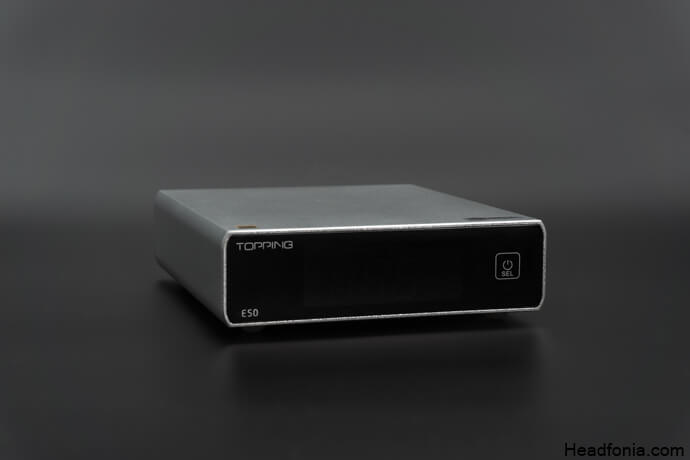
Technology Inside
The Topping E50 utilizes the ES9068AS premium-grade DAC from ESS Technology. Compared to the E30’s AK4493 chip, the 4-channel ES9068AS is a much more recent DAC. Furthermore, the E50 fully supports native MQA decoding now. Topping chose the popular, time-tested 32-bit XMOS USB chip, XU-216. The E50 can decode DSD up to DSD512 and PCM up to 32bit/768kHz natively. If you don’t know what MQA is, let me explain. In a nutshell, Master Quality Authenticated (MQA) is an audio codec that lets you stream songs in ”Master” quality. After capturing and recording the performance, MQA folds the file to make it small enough to stream or download. They call this ”Music Origami”. Products with a full MQA decoder, like the E50, unfold the file to deliver a higher rate for the user. Popular streaming service Tidal supports MQA and you can try it for a month for free and decide whether you want to keep the subscription or not. As for wireless connectivity, there isn’t any. Topping did not disclose any more information about the PCB or the components inside but the device has truly excellent measurements on paper and today you’re going to learn whether the sound quality keeps up with those impressive numbers.
Controls & UI
The E50 comes equipped with the Topping’s iconic LED display with the orange font. The display layout is quite simple. You see the volume level, sample type and rate, active input, and output. Furthermore, the E50 does not have a volume pot or any means of navigation, you only get a touch-sensitive, multifunctional button which is located on the front panel, next to the LED display. This multifunctional button supports tap and hold actions but does not let you access the complete menu without entering the ”setup menu”. You will have to press and hold the power touch button while the device is in standby mode to access this menu. I must say that without the remote, it is quite hard to navigate, select and apply individual settings so I recommend you to use the remote controller instead. I appreciate the effort that Topping has put to offer us a way to control the device with only a button without the remote though.
Let’s talk about settings. In the menu, you can control and change quite a few things. Starting with the essentials, you can toggle on the pure DAC mode, a.k.a. volume nonadjustable mode. The device comes out of the factory in pre-mode so if you aim to use it as a dedicated DAC with no volume control, you should get into the standby menu and activate this mode by selecting ”m-d” instead of ”m-p”. This option can only be changed in the standby menu but the other settings that I will list in a minute can be changed while the device is on. In the general menu, you can control the active inputs and outputs, change the PCM filter type, toggle the automatic standby on or off, and change the brightness of the display.
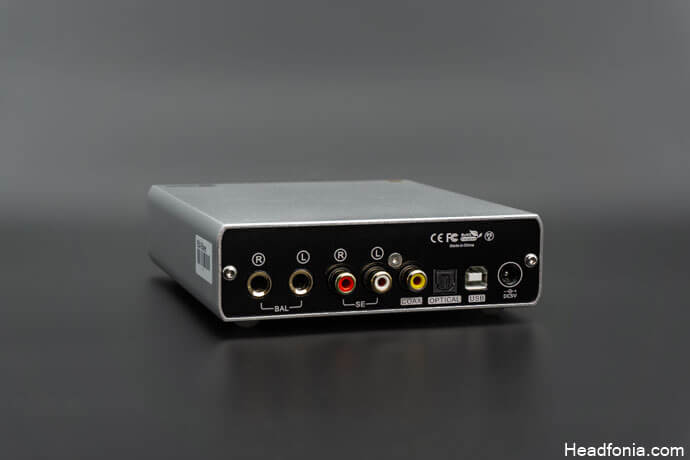
DAC Performance
In this section, I will describe the DAC’s signature, without the L50 Amp. For this test, I am pairing the DAC directly with my active reference monitors. I will also pair it with several headphone amplifiers ranging from $200 USD to $650 USD to evaluate its scaling capabilities.
The E50 sounds neutral and clean to my ears. It has a natural and organic timbre and it does not feel saturated, at all. This is not the first time I am hearing the premium-grade 9068AS, I have the SMSL SU-8S and the Gustard X16 in my inventory and they both use the same DAC chip so I am well acquainted with this DAC’s characteristics. These three units are well-implemented, well-designed, and well-made devices. The difference is nuances at the end of the day. For example, the X16 sounds slightly more detailed and slightly more linear compared to the E50 and SU-8s. The SU-8S has slightly more upper mid and treble energy and its transients feel sharper compared to the E50 and the X16. What I am trying to say is that the E50 is a very good DAC that falls short by a couple of inches from absolutely fantastic devices. This makes E50 a bargain at this price point.
Back to the presentation, what I am hearing is a DAC that is precise and accurate throughout the spectrum, without any peaks or dips. The presentation feels airy and spacious while staying faithful to the mastering of the track. It scales very well with higher-priced amplifiers such as the SMSL SP400 in fully balanced mode. I’ll be comparing the E50 & L50 combination with other popular stacks on page three so be sure not to skip that. The tonal balance of the E50 is certainly impressive and it does a great job of conveying the signature of headphones or speakers you pair it with.
The resolution on the other hand is very impressive for a DAC of this form and factor. It has a highly resolving signature and it absolutely sated my appetite and I had no intention to switch over to my daily, higher-priced rig to continue my listening session. Thanks to companies like Topping & SMSL, we don’t have to spend a fortune to get a proper, transparent and detailed DAC anymore.
Let’s look at the frequency ranges and their highlights. The low end of the DAC is fast and tight with a good punch. Tracks from Monolink puts a show of how low can the E50 get and it is impressive. It can get quite impactful with the right gear combination. The midbass is perfectly controlled and quantitatively adequate. Moving on to the midrange shows what this little DAC is truly capable of. The mids are articulate, clean, and transparent. The timbre feels right and mid-based instruments sound accurate. Listening to Lou Berry’s Blue Sky shows how detailed and clean the male vocal reproduction truly is. Upper mids carry a good amount of energy and air while staying below the ‘harsh’ threshold. Cymbals and hi-hats are snappy and the extension is top-notch for a DAC of this caliber. I must also say that the PRaT of the E50 impressed me a lot, it may be the fastest, most agile DAC I’ve heard under 300 up to this date. The treble range is no different than the rest of the spectrum. The highs are definitively clean, transparent, and extended. Pairing the DAC with the SP400 and the Hifiman DEVA provides you with a very clean, energetic treble range that is just delightful to listen to. Kudos to the team of engineers behind this product, this is a well-done product.
The review continues on Page Two, after the click HERE or by using the jump below.
Page 2:Topping L50 Desktop Amp, Packaging & Accessories, Design & Build Quality, Power & Technology, Controls, Amp Performance
Page 3: Topping E50 & L50 DAC & AMP Stack Performance, Comparisons, Pairings, Last Words





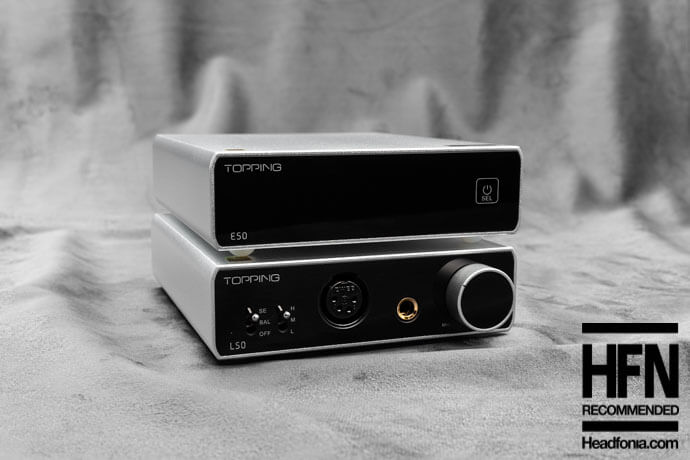
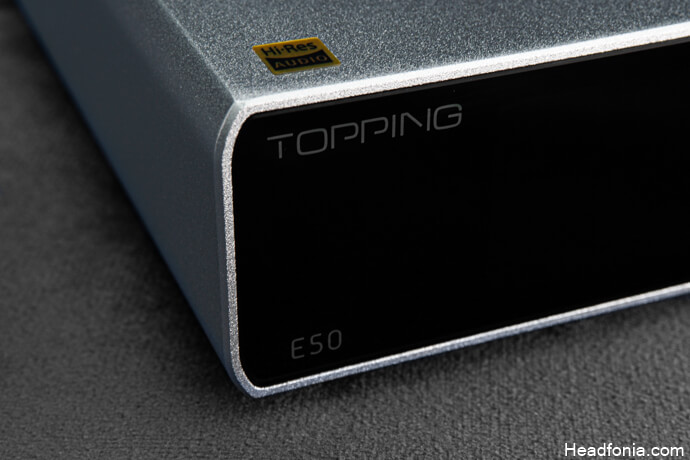
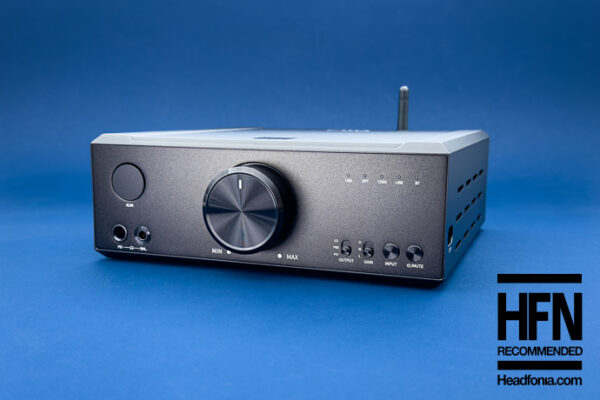
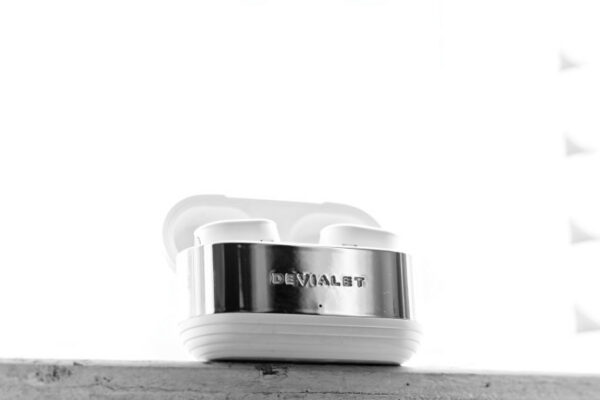
James McCook
Awesome review, ordered!!!!!
Mike
It sound little harsh in my stereo. E30 didnt sounded like this. Its heavy to listen for even few periods.
I have a raspberry 4, use flac and dac connected with rca to a onkyo amplifer. I have a pair of focal chorus. Bass are ok, but voices are harsh when goes high notes. This is my impression, and i read another user that tried to limitate this harshness, by going in preamp mode and -25 volume. But i hear the same. No way for me, sorry
Darwin
$269 and no power adapter??? I hope they enjoyed their minuscule savings, I won’t be buying one.
David Campbell
I’ve seen this movie before. Chi-Fi stepping up their game and indulging in profit. Lots of their signature black or silver box’s. Standard LED display with remote. Topping WAS a brand from 8 years ago at least that provided a bargain, or a good a deal. Today, not so much. The$300 range up or down a bit is the new $99 each from way back. Here’s the thing, it’s the same black or silver box with an updated circuit board and offering MQA as a selling point. I also used to believe in MQA. Things really got upended when Apple Music became lossless last year. Phenomenal quality NOT from compressed MQA. No sir, I understand the compression or lack there of for MQA tracks. Now I listen PRIMARILY to Apple lossless everywhere at home. Then Alexa does most everything else around the house along with her Amazon lossless files.MQA is sold on the fact that it’s truly portable. This setup is obviously meant for home use pluggwd in. So, why be at home plugged in X 2 anchored to a desktop when I can buy (and I did) a DAP w/OB MQA? Remember, MQA is certified as high res BUT, MQA is also compressed. Let me stop here!
Yagiz
Hello David, I hope you are well and thanks for your comment.
I think the MQA should not be a deciding factor. Almost all DACs now support MQA now.
I personally don’t really care about MQA as long as it’s a successful DAC.
Indrajit
Hi. I have a Topping E30 + Magni 3 and a Sennheiser hd 650. I want to upgrade my amplifier. I am planning to buy a Topping L50. May I know if the Topping L30 provides the same power output via single ended as it does with balanced? I have come across readings on internet which suggest that L50 is implicitly a single ended amp.
Yagiz
L50’s high gain is capable of delivering 600mW under 300 ohm load whereas L30 delivers around 110 mW. Why do you want to upgrade though? Both of the amplifiers are perfectly suitable with the HD650 and both of them are excellent amplifiers.
Indrajit
Hi. There was a typing error on my end. I meant to say that all the topping amps such as L30, L50 provide max power output as advertised on their websites only when the amps are fed through a dac which is an XLR input which is usually rated as 4vrms. Thus the topping L30 and L50 are not anywhere nearly as powerful as they are advertised to be at 300 ohm if they are fed through a traditional 2vrms input dac like the E30. This is my biggest concern and thus has me wondering how much power output would L30 and L50 really unleash via a traditional 2vrms input dac such as E30.
Reinhard
Hey. I wat to upgrade my e10k fiio to this. But what do you prefer best between this and smsl su sh 6 stack?
Yagiz
I’d personally go with the E50 & L50. Better overall technical capability & res. I’d also get a decent TRS cable. (Topping has a good one, alternatively you can check Aliexpress or Taobao.)
Best of luck mate.
José Countinho
im so hesitating between e50 and the new k7… purely as a dac for my speaker system (rega brio, wharfedale diamond 12.2). just soundwise, what´s better?
Thank you in advance. Great article, great website!
Yagiz
Hello Jose, as a pure DAC, definitely E50.